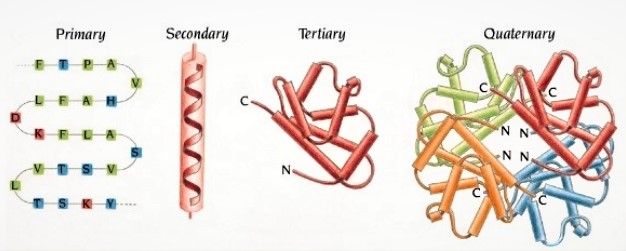Table of Contents
Millions of cells make up the human body. Each cell of our body perform definite functions. Furthermore, this involves a lot of chemical reactions. However, all these reactions are necessary for the efficient functioning of the human body. Furthermore, this is exactly where the action of enzymes come into play!
Here, in this article, firstly you will read about the definition of enzymes. Then, about its structure and types. Lastly you will read about the different functions of enzymes.
Click here for Notes on Science topics for Competitive Exams!
Definition of Enzymes
Enzymes are biological catalysts that accelerates a chemical reaction. It increases the speed of the reaction by many folds. This is due to the fact that, a decrease in activation energy increases the speed of a reaction. However, an enzyme does not alter the equilibrium of a reaction. Indeed, all the biological processes that take place in an organism are chemical reactions. Thus, they are present in all living organisms for the even functioning of the body. Moreover, all the enzymes are stereospecific. This means that, their reactions produce only a single product.
However, some of the enzymes cannot function properly unless they have a distinct non-protein molecule attached to it. They are cofactors. For instance, carbonic anhydrase.
Structure of Enzyme
1: Who was the first woman President of India?
Basically, enzymes are protein macromolecules made up of amino acids. They may be usually 100-500 amino acids long. Furthermore, they have a distinct three-dimensional structure.
Here, we shall learn the structure of enzymes under four heads. They are:
- Primary Structure
- Secondary Structure
- Tertiary Structure
- Quaternary Structure

Primary Structure
We already know that a linear chain of amino acid makes an enzyme. Have you ever wondered how these amino acids are joined together? The peptide bonds links the amino acids with each other. Consequently, the resulting amino acid chain is called a polypeptide or protein. To sum up, this is the primary structure of an enzyme.
Secondary Structure
Amino acids in the same chain can interact with each other. As a result, the polypeptide or the protein chain can double up on itself. Consequently, giving rise to two secondary 2-D structures, namely Alpha Helix and Beta Sheet. When the protein chain wraps around itself, the Alpha Helix is formed. And when the protein chain folds on top of itself, the Beta Sheet structure is formed .
Tertiary Structure
The two dimensional secondary structures formed can certainly fold up further. This results in the formation of a three dimensional structure. Hence, it is called the tertiary structure of enzyme.
Quaternary Structure
Several closely associated protein chains or sub-units are present here. Moreover, each sub-unit possess a distinct primary, secondary and tertiary structure. Various bonds hold these sub-units together. Some of them include Hydrogen bond, salt bridges, van der waals forces, etc for instance.
Get latest Recruitment Notifications on Entri App!
Free UPSKILLING Courses!
Take your first step toward mastering in-demand skills, acing interviews, and securing top-tier jobs with Entri's free upskilling courses.
Start Learning!Types of Enzymes
Enzymes are an indispensable factor for every chemical reaction in our body. Furthermore, the human cell has approximately 1300 enzymes. However, all the known-discovered enzymes are classified into six basic types. This is based on the type of the reaction that they catalyze.
They are:
- Hydrolases
- Oxidoreductases
- Transferases
- Lyases
- Ligases
- Isomerases
The suffix-ase is used to name an enzyme, as is seen above. Let us now understand about each enzyme in detail.
Hydrolases
This type of enzyme catalyzes hydrolysis reactions. For instance, they are used in reactions that use water to break a chemical bond. Therefore, a single, large molecule is broken down into smaller molecules. There are more than 200 enzymes that belong to this class, in particular.
Examples: Esterases (including lipases, phosphatases), glycosidases, etc
Oxidoreductases
It consists of a huge class of enzymes. They catalyze the transfer of electron from an electron donor to an electron acceptor molecule. Moreover, the electro donor is the redundant molecule whereas the electron acceptor is the oxidant molecule. In simple words, they catalyze oxidation- reduction reactions. Furthermore, they can be either oxidases or hydrogenases. Many significant breakthrough development has been made using this enzyme in the recent years.
Examples: Peroxidases, Hydroxylases, Oxygenases
Transferases
It is a class of more than 450 enzymes. These enzymes enable the transfer of specific functional groups from one molecule to the other. It may be a methyl or glycosyl group, for instance. Moreover, it involves a donor molecule and an acceptor molecule.
Examples: Acetate Kinase, Alanine deaminase
Lyases
This enzyme catalyzes various chemical bond breaking reactions. Furthermore, elimination reactions (except hydrolysis & oxidation) are carried out for bond breaking. Therefore, it results in the formation of a new double bond or a new cyclic structure. However, reverse reactions are also possible.
Example: Oxalate decarboxylase, Isocitrate lyase, Aldolases
Ligases
This is a class of about 50 enzymes. It catalyzes the joining of two large molecules. Furthermore, a new chemical bond is formed to achieve this. The energy required for the new bond formation is derived from the breakdown of ATP. This group of enzymes is otherwise called synthetases.
Examples: DNA Ligase, Acetyl- C0A synthetase
Isomerases
This class of enzymes catalyzes the isomerization reaction. Consequently, they convert a molecule from one isomer to the other. This enzyme plays a key role in the food industry. Furthermore, isomers have same chemical formula but different arrangement of atoms.
Examples: Alanine racemase, Glucose-phosphate isomerase
Get Unlimited Free Mock Tests on Entri! Download Today !
To sum up, we may list the different types of enzymes as given below:
| Type | Property |
| Hydrolase | Hydrolysis |
| Oxidoreductase | Electron or Hydrogen atom transfer |
| Transferase | Functional group movement |
| Lyase | Splitting chemicals |
| Ligase | Joining two molecules |
| Isomerase | Rearrangement of atoms within a molecule |
Ace your Exam Preparations with Entri
Functions of Enzymes
Enzymes are the vital proteins necessary for life. They certainly exist in all forms of lives. Basically, an enzyme works by lowering the activation energy of the chemical reactions. Moreover, they perform numerous functions. Given below are some of the functions of enzymes:
-
Signal Transduction
Enzymes are capable of participating in signal transduction. Firstly, a chain of events transmits a physical or chemical signal. This ultimately results in cellular response. Usually Kinases catalyze protein phosphorylation for signal transduction.
-
Macromolecule Breakdown
Enzymes break large molecules into smaller ones. Consequently, making the absorption process simpler. Large molecules of sugar, protein and fat are broken down into smaller molecules, for instance. Enzymes like amylases and proteases, particularly take part in this type of processes.
-
Energy Generation
Enzymes play the crucial role in generating energy. They store chemical energy in the form of ATP (Adenosine Tri Phosphate). Furthermore, this energy pilots all the other biological processes.
-
Ion Transfer
Enzymes play an important role in moving ions across the plasma membrane. They play a role in converting energy from various sources to potential energy, in addition.
-
Cell Regulation
Enzymes can also alter the internal structure of the cell to regulate cell activities. Usually these processes involves myosin ATPase, kinesin ATPase and dynein ATPase .
Enzymes also perform numerous other functions. They are involved in movement generation and immune response. Apart from this, they take part in aging processes, defense mechanism, etc for instance.
To sum up, enzymes can greatly increase the rate of any reaction without altering the equilibrium of the reaction. Apart from catalyzing the biochemical processes, they can also be extracted from cells of the body. Subsequently, enzymes catalyze a wide array of commercially important products. This, very much proves the importance of enzymes- both inside & outside the body of an organism!











